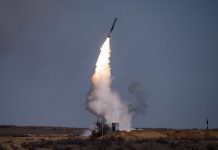The DRDO successfully completed user trials of the Extended Range Anti-Submarine Rocket (ERASR) from INS Kavaratti between June 23, 2025, and July 07, 2025.
According to the Press Information Bureau (PIB) release announcing the completion of the trials, “A total of 17 ERASRs were successfully test-evaluated at different ranges. All the specified objectives of the trials, such as range performance, electronic time fuze functioning, and warhead functioning, were successfully demonstrated.”
The maiden test of the ERASR was conducted on April 3, 2023, from the Navy’s guided missile destroyer INS Chennai.
The performance of the rocket system was evaluated at a short range of 2.7 kilometers and in long-range mode at 8.5 kilometers. The underwater blast effect of the warhead was confirmed by the onboard sonar system.
Understanding The ERASR System
The ERASR is designed to engage adversary submarines at varying depths in the vicinity of a warship. Anti-submarine rockets launched from the ERASR system can fly to a specified range between 500 meters to 8,900 meters, where they deploy depth charges that detonate at the depth where the enemy submarine is believed to be operating.
The ERASR features a dual-motor propulsion system that allows it to be fired in either Short Range or Long Range mode.
The system can be operated in single or salvo mode, depending on the tactical mission requirements.
The rocket has been designed and developed for use with Indigenous Rocket Launcher (IRL) systems on Indian Naval ships. The IRLs will replace the existing RGB rockets of the Soviet-era RBU-6000 Smerch-2 system currently fitted on IN warships, which have a lower maximum range of 5 km.
Comparison With Peer Systems
The ERASR represents a significant improvement over the RBU-6000 Smerch-2 system in terms of range. However, it still falls short of the capabilities offered by comparable systems deployed by the U.S. Navy and the People’s Liberation Army Navy (PLAN).
For instance, China’s YU-8 anti-submarine rocket vertical launch system (VLS) features rockets with a range of up to 50 kilometers, making it one of the longest-range anti-submarine rocket systems currently in service.
The U.S. Navy employs the RUR-5 ASROC and its modern variant, the RUM-139 Vertical Launch ASROC (VLA), which was originally developed in the 1950s. These systems deliver a Mark 54 Lightweight Hybrid Torpedo (LHT) to engage submarines at standoff ranges of up to 24 kilometers (RUM-139C).
Homing Torpedo Warheads
The Soviet RBU-6000 used on Indian warships used rockets that carried depth charges in their warheads. The U.S. Navy pioneered the use of a homing torpedo warhead, instead of a traditional depth charge, in anti-submarine rockets through its ASROC system.
It is believed that China’s YU-8 anti-submarine rocket VLS also carries a lightweight homing torpedo, similar to the U.S. Mark 54 or the Chinese Yu-7.
Long-range anti-submarine rocket (ASR) systems, such as the U.S. RUM-139 VLA and China’s YU-8, require advanced acoustic technology to detect and track submarines at extended ranges (24–50 km).
These systems rely on sophisticated sonar arrays and acoustic homing torpedoes to identify submerged targets in complex underwater environments, where noise, salinity, and thermoclines distort sonar signals.
Both the U.S. and China possess cutting-edge sonar processing capabilities, including AI-driven noise filtering and multi-static acoustic systems, which enable precise targeting of enemy submarines.
In contrast, India’s ERASR, with its 8.9 km range, suggests a more limited acoustic capability—likely constrained by less mature sonar integration and signal processing technology, which hampers its effectiveness in long-range anti-submarine warfare (ASW) operations.

DRDO’s SMART System
It is worth noting that the DRDO is also concurrently developing the Supersonic Missile Assisted Release of Torpedo (SMART) system for long-range anti-submarine operations.
The project, sanctioned in November 2016, aims to develop and demonstrate a cruise missile-assisted lightweight anti-submarine torpedo delivery system for ASW operations far beyond conventional torpedo range (50–650 km).
This canister-based missile system incorporates several advanced technologies, including two-stage solid propulsion, electro-mechanical actuators, and precision inertial navigation. The missile is launched from a ground mobile launcher and is capable of covering a broad range of distances.
The SMART system was last successfully tested on May 1, 2024, from Dr APJ Abdul Kalam Island off the Odisha coast.
It is likely that the DRDO is developing the SMART system for deployment by coastal batteries. However, in September 2024, it was reported that the DRDO had submitted a proposal to the Indian Navy (IN) for the development of a ship-based variant of the SMART system.
Unlike traditional shipborne ASW systems, DRDO’s SMART relies on submarine detection not through a ship’s own acoustic sensors, but through airborne, subsurface, and seabed-deployed acoustic sensors.
Historical Perspective – Cruise Missile Launched Torpedoes
The concept of a cruise missile-launched anti-submarine torpedo was first observed in the Soviet-era Club-S 91RE1 missile system. The 91RE1 is an anti-submarine ballistic missile that performs a controlled flight to the target area, where its separable warhead, a high-speed homing torpedo equipped with a sonar seeker, is deployed.
The ship-launched 91RTE2 anti-submarine ballistic missile (Club-N) differs from the 91RE1 in terms of size, weight, range, and booster design.
The 91RTE2 is longer (8.916 m vs. 7.65 m), heavier (3,105 kg vs. 2,100 kg), and has a greater maximum range (50 km vs. 40 km).
While the Indian Navy is known to operate the Klub family of missiles, it is unclear whether it possesses either the 91RE1 or 91RTE2 variants in its inventory.
Challenges Of Missile-Assisted Torpedo Launch
There are two major technological challenges in developing a missile capable of engaging a submarine at ranges of 50–650 km:
1. Detecting a submarine at such extended distances.
2. Precisely deploying a torpedo close enough to the submarine to enable successful localization and homing.
The Indian Navy (IN) has acquired the capability to detect and track submarines hundreds of kilometers from its coastline using platforms such as the MQ-9B Sea Guardian drone and the P-8I Poseidon maritime patrol aircraft.
The long reach and supersonic speed of the SMART system will enable the IN to drop a torpedo in time to be within the detection range of the acoustic sensor fitted on the torpedo itself.
ERASR Development & Manufacturing
The ERASR has been developed by DRDO’s Armament Research & Development Establishment (ARDE), Pune, in collaboration with the High Energy Materials Research Laboratory and the Naval Science & Technological Laboratory.
Bharat Dynamics Limited, Hyderabad, and Solar Defence & Aerospace Limited, Nagpur, are the production partners for ERASR rockets.
Conclusion
The successful conclusion of user trials of the ERASR system will enable the Indian Navy (IN) to induct the system aboard its warships, enhancing their ability to counter the threat posed by submarines—particularly drone submarines—in a cost-effective manner.
The logical path forward would be to incrementally enhance the capabilities of DRDO-developed sonar systems, such as the Hull-Mounted Sonar Array (HUMSA) acoustic sensors currently fitted on IN warships, in order to extend submarine detection ranges.
Simultaneously, the ERASR system could be upgraded to carry a lightweight torpedo variant, bringing its capability closer to that of long-range anti-submarine rocket systems used by advanced navies.
- Vijainder K Thakur is a retired IAF Jaguar pilot, author, software architect, entrepreneur, and military analyst.
- VIEWS PERSONAL OF THE AUTHOR
- Follow the author @vkthakur




